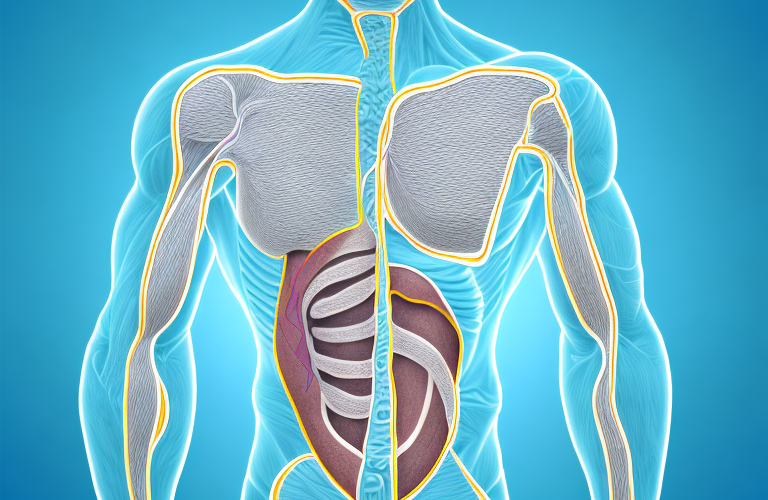Retroperitoneal fibrosis (RPF), also known as Morbus Ormond, is a rare and chronic inflammatory disorder that affects the tissue surrounding the major organs in the abdominal cavity. This condition leads to the buildup of fibrous tissue that can compress or obstruct the normal functioning of the organs in the area. Retroperitoneal fibrosis typically affects middle-aged individuals, men more than women, and can be a life-threatening condition. In this article, we will delve into the symptoms, causes, diagnosis, treatment, and prevention strategies of retroperitoneal fibrosis.
Understanding Retroperitoneal Fibrosis: An Overview
Retroperitoneal fibrosis is a progressive condition that affects the retroperitoneal space, which is the area behind the abdomen that houses the kidneys, adrenal glands, and other major vessels and organs. The primary hallmark of retroperitoneal fibrosis is the accumulation of fibrotic tissue that can lead to the compression or obstruction of the organs in the area, causing various symptoms. The fibrous tissue can also encroach upon the ureters, which are tubes that connect the kidneys to the bladder, leading to blockages and kidney problems.
The exact cause of retroperitoneal fibrosis is unknown, but it is believed to be an autoimmune disorder, where the body’s immune system mistakenly attacks healthy tissue in the retroperitoneal space. Other possible causes include infections, medications, and genetic factors. Retroperitoneal fibrosis is a rare condition, affecting only a small percentage of the population.
The symptoms of retroperitoneal fibrosis can vary depending on the severity and location of the fibrotic tissue. Common symptoms include abdominal or back pain, weight loss, fever, and swelling in the legs. If left untreated, retroperitoneal fibrosis can lead to kidney failure and other serious complications. Treatment options include medications to reduce inflammation and surgery to remove the fibrotic tissue and restore organ function.
What Causes Retroperitoneal Fibrosis?
The exact cause of retroperitoneal fibrosis is still unknown, but research suggests that it may result from an abnormal immune response that triggers the inflammation and the deposition of fibrotic tissue. Additionally, certain medications, infections, and autoimmune disorders have been linked to the development of retroperitoneal fibrosis. Certain genetic and environmental factors may also play a role in the development of this condition.
Recent studies have also shown a possible association between retroperitoneal fibrosis and exposure to certain chemicals and toxins. Exposure to asbestos, for example, has been linked to an increased risk of developing this condition. Other environmental factors, such as smoking and air pollution, may also contribute to the development of retroperitoneal fibrosis.
It is important to note that retroperitoneal fibrosis is a rare condition, affecting only a small percentage of the population. However, it is more commonly diagnosed in men over the age of 40. If you experience symptoms such as abdominal pain, weight loss, or difficulty urinating, it is important to seek medical attention promptly. Early diagnosis and treatment can help manage symptoms and prevent complications.
Signs and Symptoms of Retroperitoneal Fibrosis
Retroperitoneal fibrosis can present with a range of symptoms that often develop slowly and progressively. The most common symptoms include recurrent abdominal pain, lower back pain, flank pain, weight loss, fatigue, and swelling in the legs. Patients with retroperitoneal fibrosis may also experience urinary symptoms such as frequency, urgency, and difficulty passing urine, and blood in the urine. In severe cases, patients may develop kidney failure due to the blockage of the ureters.
Aside from the aforementioned symptoms, retroperitoneal fibrosis can also cause fever, night sweats, and loss of appetite. These symptoms are often associated with inflammation and infection, which can occur as a result of the fibrosis. Patients may also experience pain or discomfort during sexual intercourse, as the fibrosis can affect the reproductive organs.
It is important to note that retroperitoneal fibrosis is a rare condition, and its symptoms can be similar to those of other medical conditions. Therefore, it is crucial to seek medical attention if you experience any of the symptoms mentioned above, especially if they persist or worsen over time.
Diagnosis and Tests for Retroperitoneal Fibrosis
Diagnosing retroperitoneal fibrosis can be challenging due to its rare and non-specific symptoms. The diagnostic tests range from blood and urine tests, imaging tests such as X-rays, CT scans, and MRI scans, to a biopsy of the affected tissue. The doctor may also perform a cystoscopy to examine the bladder and urethra or a ureteroscopy to examine the inside of the ureter for blockages. An accurate diagnosis of retroperitoneal fibrosis is essential to commence treatment and prevent further complications.
It is important to note that the symptoms of retroperitoneal fibrosis can mimic those of other conditions such as kidney stones, urinary tract infections, and prostate cancer. Therefore, a thorough medical history and physical examination are crucial in determining the appropriate diagnostic tests.
In some cases, a positron emission tomography (PET) scan may also be used to detect inflammation in the affected area. This test involves injecting a small amount of radioactive material into the body, which is then detected by a special camera to produce detailed images of the affected tissue.
Treating Retroperitoneal Fibrosis: Your Options
There is no cure for retroperitoneal fibrosis, and treatment aims at managing the symptoms, slowing the progression of the condition, and preventing complications. The treatment options for retroperitoneal fibrosis vary depending on the extent and severity of the condition. They may include medications, surgery, and lifestyle modifications.
One of the most common medications used to treat retroperitoneal fibrosis is corticosteroids. These drugs help to reduce inflammation and swelling in the affected area, which can alleviate symptoms such as pain and discomfort. Other medications that may be used include immunosuppressants and chemotherapy drugs, which can help to slow the progression of the condition.
In some cases, surgery may be necessary to treat retroperitoneal fibrosis. This may involve removing the fibrous tissue that is causing the blockage, or bypassing the affected area to allow blood and other fluids to flow freely. Lifestyle modifications such as quitting smoking, maintaining a healthy weight, and exercising regularly can also help to manage symptoms and prevent complications.
Medications for Retroperitoneal Fibrosis
Medications are often the first line of treatment for retroperitoneal fibrosis, and they aim at reducing the inflammation and relieving the symptoms. The medications prescribed may include corticosteroids, immunosuppressants, and pain relievers. These drugs may have side effects, and the doctor will weigh the benefits against the risks before prescribing them.
In addition to medications, lifestyle changes can also help manage retroperitoneal fibrosis. Patients are advised to quit smoking, maintain a healthy weight, and exercise regularly. These lifestyle changes can help reduce inflammation and improve overall health.
In some cases, surgery may be necessary to remove the fibrous tissue causing the blockage. This is typically reserved for cases where medications and lifestyle changes have not been effective in managing symptoms. The type of surgery performed will depend on the location and severity of the fibrosis.
Surgical Treatment for Retroperitoneal Fibrosis
In severe cases of retroperitoneal fibrosis, surgical intervention may be necessary to restore normal function to the affected organs and structures. The surgical options may include bypass surgery to reroute blood flow, ureteral stenting to alleviate blockages, or surgical removal of the affected tissue if deemed necessary. The surgical approach will depend on the area affected and the extent of the fibrotic tissue.
It is important to note that surgery for retroperitoneal fibrosis is not always successful and may come with risks and complications. Patients may experience bleeding, infection, or damage to surrounding organs during the procedure. Additionally, surgery may not completely eliminate the fibrotic tissue and symptoms may persist or recur.
After surgery, patients will need to undergo regular follow-up appointments to monitor their condition and ensure that the surgery was successful. They may also need to make lifestyle changes, such as quitting smoking or maintaining a healthy weight, to prevent the fibrosis from returning.
Lifestyle Changes for Managing Retroperitoneal Fibrosis
Lifestyle modifications can be beneficial in managing the symptoms and improving the overall quality of life in patients with retroperitoneal fibrosis. The recommended lifestyle changes may include quitting smoking, maintaining a healthy weight, consuming a balanced diet, engaging in regular physical activity, and reducing. Stress. The doctor may also recommend regular follow-up visits to monitor the condition and prevent complications.
In addition to lifestyle changes, medication may also be prescribed to manage the symptoms of retroperitoneal fibrosis. This may include nonsteroidal anti-inflammatory drugs (NSAIDs) to reduce inflammation and pain, corticosteroids to suppress the immune system, and immunosuppressive drugs to prevent the immune system from attacking the affected tissues. In some cases, surgery may be necessary to remove the fibrous tissue and relieve pressure on the affected organs.
Coping with the Emotional Impact of Retroperitoneal Fibrosis
Coping with the diagnosis and treatment of retroperitoneal fibrosis can be challenging and take a toll on a patient’s mental and emotional well-being. Patients can benefit from support groups, counseling, and other mental health services as they learn to cope with the effects of the condition on their lives.
One of the most common emotional impacts of retroperitoneal fibrosis is anxiety. Patients may feel anxious about the uncertainty of their condition, the effectiveness of their treatment, and the potential for future complications. It is important for patients to communicate their concerns with their healthcare team and seek professional help if needed.
In addition to anxiety, depression is also a common emotional response to retroperitoneal fibrosis. Patients may feel overwhelmed by the physical and emotional toll of the condition, as well as the impact it has on their daily lives. Seeking support from loved ones and mental health professionals can help patients manage their symptoms and improve their overall well-being.
Prevention Strategies for Reducing the Risk of Retroperitoneal Fibrosis
There are no known primary prevention strategies for retroperitoneal fibrosis at present. However, adopting a healthy lifestyle, avoiding potential triggers, and seeking medical attention promptly when symptoms manifest can reduce the risk of developing this condition and other associated complications.
In conclusion, Retroperitoneal fibrosis is a rare, chronic condition that affects the abdominal region and can lead to organ failure if left untreated. However, with early diagnosis and prompt treatment, patients can manage the symptoms and improve their quality of life. Any symptoms related to retroperitoneal fibrosis should be reported to a medical professional for proper diagnosis and treatment.
It is important to note that retroperitoneal fibrosis can be associated with certain medications, such as methysergide and beta-blockers. Therefore, patients who are prescribed these medications should be closely monitored for any symptoms of retroperitoneal fibrosis. Additionally, individuals with a history of autoimmune disorders or inflammatory conditions may be at a higher risk for developing retroperitoneal fibrosis and should discuss this with their healthcare provider.










